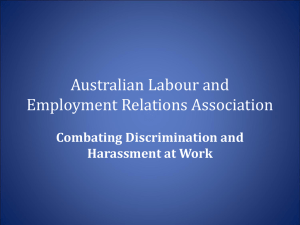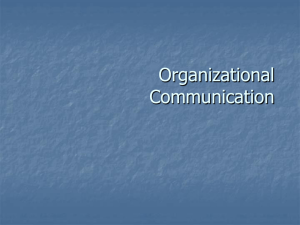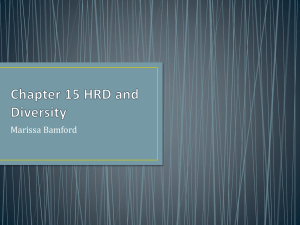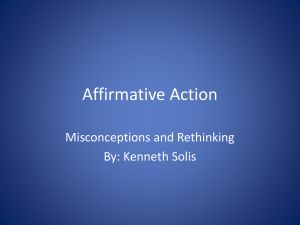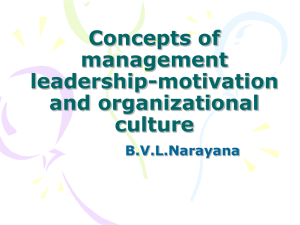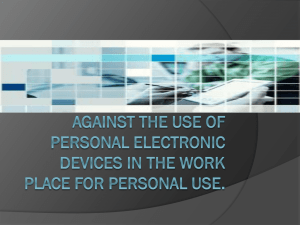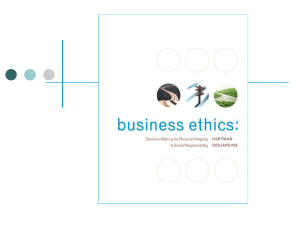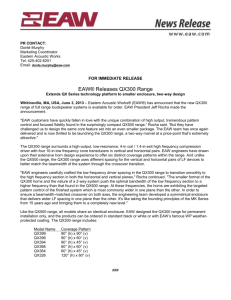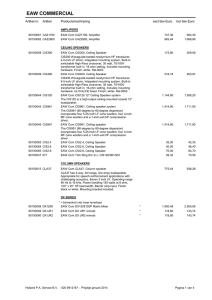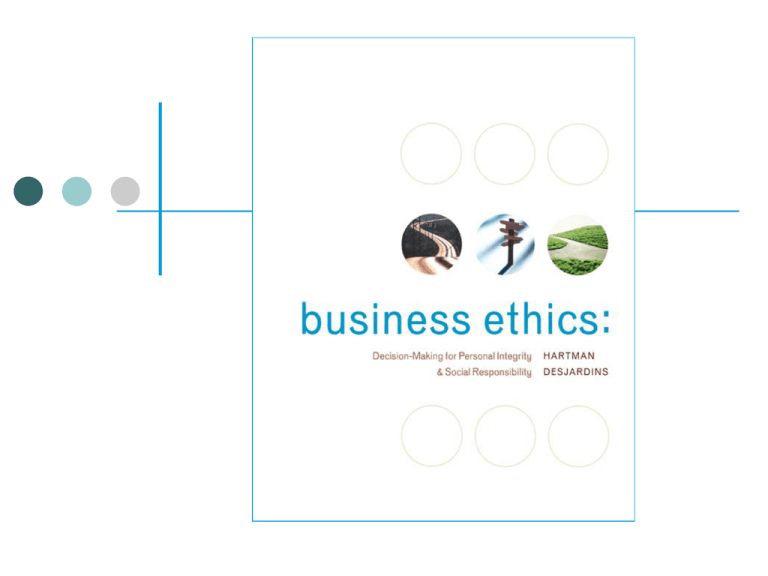
Chapter
6
Ethical Decision-Making:
Employer Responsibilities and
Employee Rights
McGraw-Hill/Irwin
Business Ethics: Decision-Making for Personal Integrity
& Social Responsibility
Copyright © 2008
6-2
1-2
The McGraw-Hill Companies, Inc. All rights reserved.
Chapter Objectives
After exploring this chapter, you will be able to:
1. Discuss the two distinct perspectives on the ethics of workplace
relationships.
2. Explain the concept of due process in the workplace.
3. Define “employment at will” and its ethical rationale.
4. Describe the costs of an EAW environment.
5. Explain how due process relates to performance appraisals.
6. Discuss whether it is possible to downsize in an ethical manner
7. Explain the difference between intrinsic and instrumental value
in terms of health and safety
8. Describe the “acceptable risk” approach to health and safety in
the workplace
6-3
1-3
Chapter Objectives
After exploring this chapter, you will be able to:
9. Describe the nature of an employer’s responsibility with regard
to employee health and safety and why the market is not the
most effective arbiter of this responsibility
10. Explain the basic arguments for and against regulation of the
global labor environment
11. Describe the argument for a market-based resolution to
workplace discrimination.
12. Define diversity as it applies to the workplace.
13. Explain the benefits and challenges of diversity for the
workplace.
14. Define affirmative action and explain the three ways in which
affirmative action may be legally permissible.
15. Articulate the basic guidelines for affirmative actions programs
6-4
1-4
Decision-Making @ Work
There are two very distinct, and sometimes competing,
perspectives on the ethics of workplace relationships.
On one hand, employers might decide to treat employees well as a
means to produce greater workplace harmony and productivity.
On the other hand, of course, employers might treat employees
well out of a Kantian sense of duty and rights, regardless of the
either utilitarian or self-interested productivity consequences.
6-5
1-5
Defining the Parameters of
the Employment Relationship:
Due Process
Philosophically, the right of due process is the right to be
protected against the arbitrary use of authority.
Due process in the workplace acknowledges an employer’s authority
over employees.
Employers can tell employees what to do and when and how to do it.
They can exercise such control because they retain the ability to
discipline or fire an employee who does not comply with their authority.
Because of the immense value that work holds for most people, the threat
of losing one’s job is a powerful motivation to comply.
However, basic fairness—implemented through due process—demands
that this power be used justly.
6-6
1-6
Employment at Will
Ironically, the law has not always clearly supported this
mandate of justice.
Much employment law within the United States instead
evolved in a context of a legal doctrine known as
“Employment at Will.”
Absent a particular contractual or other legal obligation that
specifies the length or conditions of employment, all employees
are employed “at will.”
Unless an agreement specifies otherwise, employers are free to
fire an employee at any time and for any reason.
In the same manner, an EAW worker may opt to leave a job at any
time for any reason, without offering any notice at all; so the
freedom is theoretically mutual.
6-7
1-7
Reasons to Limit EAW
Justice Argument: Even if EAW proved to be an effective
management tool, justice demands that such tools not be used to
harm other people.
Property Argument: Even if private property rights grant
managers authority over employees, the right of private property
itself is limited by other rights and duties. Also
Lack of Mutuality: Though the freedom to terminate the
relationship is theoretically mutual, the employer is often
responsible for the employee’s livelihood, while the opposite is
unlikely to be true; so the differential creates an unbalanced power
relationship between the two parties.
6-8
1-8
Downsizing
Terminating workers – whether one or one hundred – is not
necessarily an unethical decision.
However, the decision itself raises ethical quandaries since there
may be alternatives available to an organization in financial
difficulty.
Once the decision has been made, are there ways in which an
organization can act more ethically in the process of
downsizing?
How might our earlier discussion on due process and fairness
offer some guidance and/or define limitations in a downsizing
environment?
6-9
1-9
Health & Safety
In U.S. and elsewhere in developed countries, there is consensus
that employees have a fundamental right to a safe and healthy
workplace.
In some other regions, employees lack even the most basic health
and safety protections, such as in working environments that are
often termed “sweatshops.”
Even within the U.S., this issue becomes quite complicated upon
closer examination. There is disagreement as to the extent of an
employer’s responsibility for workplace health and safety as well
as the best policies to protect worker health and safety.
6-10
1-10
Health & Safety
as “Acceptable Risk”
Employers cannot be responsible for providing an ideally safe
and healthy workplace.
Instead, discussions in ethics about employee health and
safety will tend to focus on the relative risks faced by workers
and the level of acceptable workplace risk.
In this discussion, “risks” can be defined as the probability of
harm, and we determine “relative risks” by comparing the
probabilities of harm involved in various activities.
6-11
1-11
Health & Safety
as “Acceptable Risk”
It is an easy step from these calculations to certain
conclusions about acceptable risks.
If it can be determined that the probability of harm involved
in a specific work activity is equal to or less than the
probability of harm of some more common activity, then we
can conclude that this activity faces an “acceptable level of
risk.”
From this perspective, a workplace is
“safe” if the risks are “acceptable.”
6-12
1-12
Challenges to Market
Control of H&S
Labor markets are not perfectly competitive and free.
Employees do not have the kinds of free choices that the free
market theory would require in order to attain optimal
satisfactions.
Second, employees seldom, if ever, possess the kind of
complete information required by efficient markets. If
employees do not know the risks involved in a job, they will
not be in a position to freely bargain for appropriate wages
and therefore are not in a position to effectively protect their
rights or ensure the most ethical consequences.
6-13
1-13
The Global Workforce
The laws were have discussed so far apply to workers who
are employed in the United States.
Workers outside of the United States may be subject to some
US laws if they work for an American-based organization,
though enforcement is scattered.
In some cases, workers in other countries are often protected
by even more stringent laws than those in the US.
But in many other cases, especially in certain developing
countries, workers find themselves subject to conditions that
US-based workers would find appalling.
6-14
1-14
Rights and Responsibilities in Conflict:
Discrimination, Diversity and Affirmative
Action
With regard to the above issues, we are discussing several
matters that remain open to debate by scholars, jurists and
corporate leaders.
The focus is on those subtle areas where perhaps the law has
not yet become so settled, where it remains open to diverse
cultural interpretations, strong minority opinions, and value
judgments.
Though the courts are often forced to render judgment, their
decisions might result from a non-unanimous vote or through
the reversal of a strong lower court opinion representing a
contrary perspective.
6-15
1-15
Philosophical Application
From a Kantian, deontological perspective, there is not yet
universal agreement on the fundamental rights that are
implicated by these issues, nor on their appropriate
prioritization.
From a utilitarian viewpoint, neither do these reasonable
minds always agree on which resolution might lead toward
the greatest common good, or even what that good should be
ultimately.
Distributive justice does not provide a clear cut solution as
there is often an argument for fairness from each camp and
other theories provide similar quandaries.
6-16
1-16
Diversity
Diversity refers to the presence of
differing cultures, languages,
ethnicities, races, affinity orientations,
genders, religious sects, abilities,
social classes, ages and national
origins of the individuals in a firm.
Benefits and Challenges of
Diversity for the Workplace
When a firm brings together individuals with these (or other)
differences – often exposing these individuals to these differences
for the first time – there are likely to be areas of tension and
anxiety.
In addition, the organization is likely to ask that they work together
toward common goals, on teams, in supervisory or subordinate
roles, in power relationships, all requests that might lead to
conflicts or tension even without additional stressors such as
cultural challenges.
There are several areas of potentially increased values tension with
regard to diversity. Where differences are new or strong, and
where negative stereotypes previously ruled interactions between
particular groups, sensitivity to the potential for conflict is
necessary.
6-18
1-18
Benefits and Challenges,
continued
Another concern involves integrating diverse viewpoints with a
pre-existing corporate culture.
There seems nothing inappropriate about seeking to ensure that
workers will support the particular values of a firm, but it might be
difficult to do this while also encouraging diversity.
The diversity that might be the source of positive gains for the
organization might also be the source of challenging fundamental
differences and these differences must be balanced.
Some scholars suggest that job applicants be screened with regard
to their values – but how does one do this?
6-19
1-19
Affirmative Action
Defined: A policy or a program that tries to respond to instances where
there has been some past discrimination by implementing proactive
measures in order to ensure equal opportunity today.
It may take the form of intentional inclusion of previously excluded
groups in employment, education or other environments.
Does one person deserve a position more than another person?
For instance, efforts to encourage greater diversity may also be seen as a
form of “reverse discrimination” - in other words, discrimination against
those individuals who are traditionally considered to be in power or the
majority, such as white men.
A business that intentionally seeks to hire a candidate from an
underrepresented group might be seen as discriminating against white
males, for example.
6-20
1-20
Guidelines for Affirmative
Action Programs
Consider how the following legal constraints to an affirmative action
program are in line with deontological and teleological frameworks that
support ethical decision-making, as well:
The affirmative action efforts or policy may not unnecessarily infringe
upon the majority employees’ rights or create an absolute bar to their
advancement.
The affirmative action effort or policy may not set aside any positions
for women or minorities and may not be construed as quotas to be met.
It should unsettle no legitimate, firmly rooted expectation of employees.
It should be only temporary in that it is for the purpose of attaining, not
maintaining, a balanced workforce.
It should represent a minimal intrusion into the legitimate, settled
expectations of other employees.
6-21
1-21
Opposition to Affirmative
Action Programs
Opponents claim that the efforts do more harm than good, that they
create ill will and poor morale among work forces.
They argue that they translate into current punishment of past wrongs
and therefore are inappropriately placed since those who “pay” for the
wrongs are unfairly burdened and should not bear the responsibility for
the acts of others.
It is not merely the white males who articulate this claim. Ward
Connerly, an African-American Regent of the University of California
discussed affirmative action during a 60 Minutes interview and stated,
“Black Americans are not hobbled by chains any longer. We’re free to
compete. We’re capable of competing. It is an absolute insult to suggest
that we can’t.”
6-22
1-22
Chapter Six Vocabulary Terms
After examining this Chapter, you should have a clear understanding of the following
Key Terms and you will find them defined in the Glossary:
Affirmative Action
Child Labor
Discrimination
Diversity
Downsize
Due Process
Employment at Will (EAW)
Just Cause
Multiculturalism
OSHA
“Reverse” discrimination
Sweatshops
6-23
1-23


